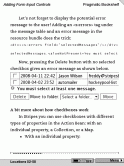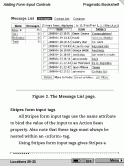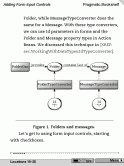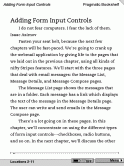If e-book readers are to ever catch on then they must be able to display all kinds of documents and information, from novels to picture albums to technical documents. This presents a challenge for publishers right now because whist e-book readers are catching on, they don’t posses the technology to display anything other than just words and simple black and white images. A lot of publishers are wanting to put their technical documents on to e-ink devices, however technology in the e-ink industry is limiting how those documents can be displayed.
Once such publisher is Dave Thomas from Pragmatic Programmer which publishes technical programming books, as you can imagine, programming books will be full of diagrams, tables, code lists and images — they are really tricky to reproduce for e-book viewing.
This is what Dave had to say
About once a week, we get a request from a reader to have our books available in a format that can be read on an eBook reader (typically, nowadays, the Amazon Kindle).
In fact, we’ve had a prototype form of that capability for a while now, but we’ve always held back. Frankly, we didn’t think the devices worked well with our kind of content. Basically, the .mobi format used by the Kindle is optimized for books that contain just galleys of text with the occasional heading. Throw in tables, monospaced code listings, sidebars and the like, and things start to get messy. The .epub format (used, for example, by Adobe Digital Editions) is slightly more capable, but it also has issues.
You can see exactly what Dave is talking about because he has uploaded his tests, you can see the results here;
Dave goes on to say getting to this stage required a lot of hacks, for instance the code listings have been converted to images so that they render better, however they don’t scale when the user changes the font size — i’m sure many more hacks were used to get to this stage, Dave finises with a good question:
So… what do you think. Is this workable? Should we make these available, even though they’re not very good, or should we wait for a later generation of eBook that’s closer to the capabilities we need? Comments are open… :)
What do you think, should publishers wait or press on knowing this is the best possible outcome given the current technology?




It is not true that epub is insufficient for technical materials and high quality typography. I have posted a few samples at http://www.hindawi.com/epub.html that contains lots of mathematical equations and graphics and some tabular materials. epub is capable of embedding OpenType fonts (which makes me surprised when people complain about the lake of a fixed width font for computer codes) and also supports Scalable Vector Graphics (SVG). Almost anything you can do in a PDF, you can do in epub using SVG.
Why waste time on a single-purpose devices like an ebook when there is already a solution that allows zooming, text, color images, animated graphs, video, etc? I’ll admit the screen is small, but iPhones and iPod Touches are a perfect solution, not to mention wireless download and sharing capabilities.
exactly because the screen is so small.
it’s also considerably more expensive than a simple e-reader
some people will want all the other features and not care about the screen size, but others prefer a device that is good for reading, even if it means carrying an additional device.
I read a _lot_ of stuff on my kindle, some of it very much like what is being described, and I find that there are versions out there that work well and ones that don’t
in any case, there’s no good reason to not make the material available in existing formats just because a particular format is not perfect. sometimes the convienience of having the text available (and searchable) vastly outweighs the loss of all formatting and diagrams, so a plain text version would be worthwhile to have.